Geb 3213 chapter 10 - Study guides, Class notes & Summaries
Looking for the best study guides, study notes and summaries about Geb 3213 chapter 10? On this page you'll find 42 study documents about Geb 3213 chapter 10.
Page 3 out of 42 results
Sort by
GEB 3213 Chapter 12 Questions and Answers 100% Solved
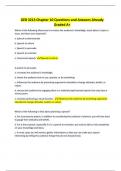
-
GEB 3213 Chapter 10 Questions and Answers Already Graded A+
- Exam (elaborations) • 14 pages • 2024
- Available in package deal
-
- $9.89
- + learn more
Which of the following allows you to increase the audience's knowledge, teach about a topic or issue, and share your expertise? a. Speech to demonstrate b. Speech to inform c. Speech to persuade d. Speech to entertain e. Ceremonial speech Speech to inform A speech to persuade: a. increases the audience's knowledge. b. shows the audience how to use, operate, or do something. c. influences the audience by presenting arguments intended to change attitudes, beliefs, or values. d. amuse...
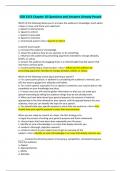
-
GEB 3213 Chapter 10 Questions and Answers Already Passed
- Exam (elaborations) • 9 pages • 2023
-
Available in package deal
-
- $9.99
- + learn more
Which of the following allows you to increase the audience's knowledge, teach about a topic or issue, and share your expertise? a. Speech to demonstrate b. Speech to inform c. Speech to persuade d. Speech to entertain e. Ceremonial speech<<Ans>>Speech to inform A speech to persuade: a. increases the audience's knowledge. b. shows the audience how to use, operate, or do something. c. influences the audience by presenting arguments intended to change attitudes, beliefs, or values. d....

-
GEB 3213 Chapter 10 Questions and Answers Already Graded A+
- Exam (elaborations) • 14 pages • 2023
-
- $12.49
- + learn more
GEB 3213 Chapter 10 Questions and Answers Already Graded A+ Which of the following allows you to increase the audience's knowledge, teach about a topic or issue, and share your expertise? a. Speech to demonstrate b. Speech to inform c. Speech to persuade d. Speech to entertain e. Ceremonial speech Speech to inform A speech to persuade: a. increases the audience's knowledge. b. shows the audience how to use, operate, or do something. c. influences the audience by presenting argument...
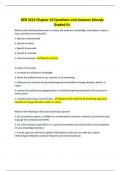
-
GEB 3213 Chapter 10 Questions and Answers Already Graded A+
- Exam (elaborations) • 14 pages • 2024
-
Available in package deal
-
- $8.99
- + learn more
GEB 3213 Chapter 10 Questions and Answers Already Graded A+ Which of the following allows you to increase the audience's knowledge, teach about a topic or issue, and share your expertise? a. Speech to demonstrate b. Speech to inform c. Speech to persuade d. Speech to entertain e. Ceremonial speech Speech to inform A speech to persuade: a. increases the audience's knowledge. b. shows the audience how to use, operate, or do something. c. influences the audience by presenting arguments intended ...
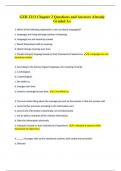
-
GEB 3213 Chapter 2 Questions and Answers Already Graded A
- Exam (elaborations) • 13 pages • 2023
-
Available in package deal
-
- $9.49
- + learn more
GEB 3213 Chapter 2 Questions and Answers Already Graded A+ 1. Which of the following statements is not true about language(s)? a. Languages are living exchange systems of meaning. b. Languages are not bound by context. c. Words themselves hold no meaning. d. Words change meaning over time. e. People interpret language based on their framework of experience. b. Languages are not bound by context. 2. According to the famous linguist Hayakawa, the meaning of words: a. is ontological. b...
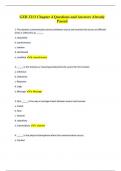
-
GEB 3213 Chapter 4 Questions and Answers Already Passed
- Exam (elaborations) • 8 pages • 2023
-
Available in package deal
-
- $9.49
- + learn more
GEB 3213 Chapter 4 Questions and Answers Already Passed 1. The dynamic communication process between source and receiver that occurs at different times is referred to as _____. a. sequential b. asynchronous c. random d. distributed e. stratified b. asynchronous 2. _____ is the stimulus or meaning produced by the source for the receiver. a. Inference b. Deduction c. Response d. Logic e. Message e. Message 3. A(n) _____ is the way a message travels between source and receiver....
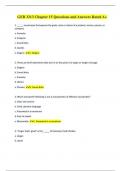
-
GEB 3213 Chapter 15 Questions and Answers Rated A+
- Exam (elaborations) • 12 pages • 2023
-
Available in package deal
-
- $9.49
- + learn more
GEB 3213 Chapter 15 Questions and Answers Rated A+ 1. _____ are phrases that express the goals, aims or nature of a product, service, person, or company. a. Proverbs b. Snippets c. Sound bites d. Quotes e. Slogans e. Slogans 2. These are brief statements that zero in on the point of a larger or longer message. a. Slogans b. Sound bites c. Proverbs d. Idioms e. Phrases b. Sound bites 3. Which among the following is not a characteristic of effective sound bites? a. Clear and ...
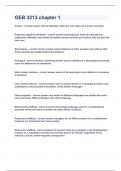
-
GEB 3213 chapter 1|WITH 100% COMPLETE SOLUTIONS|ALREADY GRADED A|GUARANTEED SUCCESS
- Exam (elaborations) • 2 pages • 2023
-
- $11.99
- + learn more
Culture shared attitudes, behavior, and values of a group of people Projected cognitive similarity assuming you know the perceptions, judgments, attitudes, and values of another person because you believe they are just like your own Stereotypes mental representations of other peoples and cultures that fit into specific per-judged behavioral patterns Prototype examining another person initially by a stereotype but leaving room for differences in individuals High co...
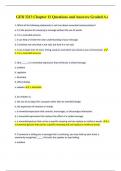
-
GEB 3213 Chapter 11 Questions and Answers Graded A+
- Exam (elaborations) • 14 pages • 2023
-
Available in package deal
-
- $9.49
- + learn more
GEB 3213 Chapter 11 Questions and Answers Graded A+ 1. Which of the following statements is not true about nonverbal communication? a. It is the process of conveying a message without the use of words. b. It is a reversible process. c. It can help or hinder the clear understanding of your message. d. It involves not only what is not said, but how it is not said. e. It can include tone of voice, timing, posture, and where you stand as you communicate. b. It is a reversible process. 2....

How did he do that? By selling his study resources on Stuvia. Try it yourself! Discover all about earning on Stuvia



